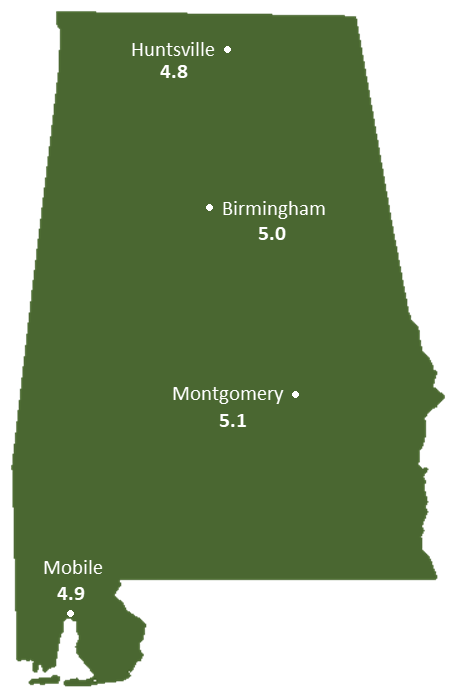Alabama Sunlight Hours & Renewable Energy Information

Quick Green Energy Summary for Alabama
Sunlight
State Sunlight Rank: 33/50
Average Annual Sunlight Hours: 2600 hours
Clear Days: 99 days per year
Summer Peak Sun Hours: 4.69 hours per day
Winter Peak Sun Hours: 3.37 hours per day
Average Peak Sun Hours  : 4.23 hours per day
: 4.23 hours per day
Wind
State Wind Rank  : 37/50
: 37/50
Average Annual Wind Speed: 0.04 miles per hour
More Information on Alabama Green Energy
The average peak sun hours for solar power in Alabama shown above is 4.23 hours per day, but that is with a fixed and non-tracking solar panel, so it can be interpreted as a minimum number. Alabama is a pretty sunny southern state, so with a tracking mount the peak sun hours could be increased dramatically.
Alabama ranks 33rd out of the 50 states in sunshine, and has a lot of potential to increase the amount of solar power used in the state with a decent amount of peak sun hours per day. The central region of the state gets a little more sunlight than cities to the North or along the coast.
Alabama does not have a lot of commercial solar power, but it still could be a reliable option for private home owners. Installing a solar power system in Alabama could be expensive up front costing up to around $40,000 to install, but the average cost of electricity in the state is $0.125 per kw hour, which is about $1800 a year. So a solar panel system could begin to pay for itself pretty quickly. Alabama is one of four states in the country to not have adopted state net metering laws, so the net metering parameters need to be negotiated with the utility companies themselves.
A fixed tilt solar panel does not change angles to adjust with the sun, so looking at the average peak sun hours using a fixed tilt panel can set a good baseline for calculations. On average, the state of Alabama receives 4.23 daily peak sun hours.
This number obviously changes if you were to drill down and examine the peak sunlight hours on a daily basis because of the number of factors that can affect a solar panels ability. Natural factors, such as cloud coverage, weather, time of year and much more all impact the daily sun light hours and amount of solar insolation. Not every hour of sunlight will be converted at the same efficiency ratio, so it can help to look at the average when planning for your year.
 :
: